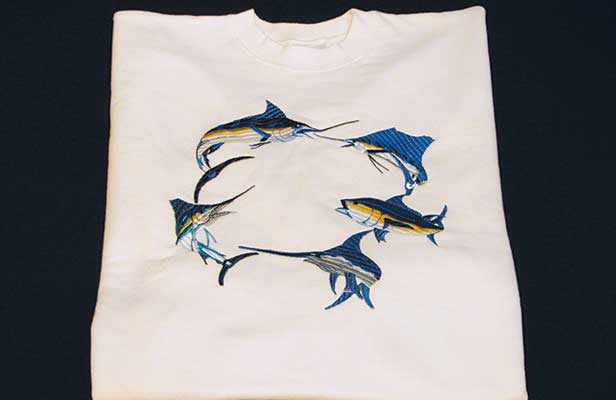October 09, 2019
How To Reduce Stitch Count Without Jeopardizing Quality
When it comes to embroidery, there’s a fine line between too many stitches and not enough. Excessive stitch coverage can lead to problems like thread breaks, needle breaks, holes in the garment and fabric distortion. Not having enough stitches to provide proper coverage will lead to poor quality, as the fabric will be visible through the design. This is unacceptable and will likely result in an unhappy customer. Try one of these techniques to reduce the number of stitches in a design, saving you time and money without compromising quality.
Resize the Design: Perhaps the simplest way to shave off some stitches is to resize the design. Before doing so, first analyze the design to ensure that it’s suitable for size reduction: Will the elements sew properly at a smaller size? Does the smaller size work for the intended application? Is the design in an outline format? If not, the stitch count won’t decrease when shrunk.

You can shave thousands of stitches off this design by reducing its size by 5% to 10%.
Adjust the Density: Try reducing the density of satins and fills. A 2-inch-by-2-inch fill segment with a density of 63.5 stitches per inch (spi) has about 6,917 stitches. If you reduce this to 50 spi, the new coverage is about 6,188 stitches. Dropping the density to 40 spi yields a stitch count of 5,648. That’s actually a significant change for such a small area, so be sure there’s still enough coverage for the specified fabric.
Focus on the type of fabric the design will be sewn on. Smooth, stable fabrics such as denim can usually handle a greater reduction in density than knits or fabrics with a textured surface.
Another way to reduce the density of a given segment without giving up thread coverage is to use a heavier thread weight.
Increase Stitch Length: Most software systems have a default running stitch length of 3 mm. If you had a segment that was 36 mm long, you would expect it to have 12 stitches, each being 3 mm long. If you increased the stitch length to 4 mm, you would only have nine stitches. This sounds easy enough, but is it appropriate for the design? For straight lines, longer running stitches are usually OK, but for curved lines, longer stitches don’t generally provide smooth curves. In addition, short running stitches are preferred over longer ones when creating fine detail.
Most commercial machines automatically reduce speed for stitches that exceed 4 mm. This is crucial. If you reduce stitch count by increasing running stitches to 4 mm (or longer), then the machine may slow down and take longer to sew. This is counterproductive if you’re using stitch count pricing, as you achieved no production gains by reducing the stitch count.
Change Stitch Types: A fill segment that’s 10 mm by 40 mm with a density of 4 points has 626 stitches. By changing it to a satin segment with the same density, the stitch count drops to 217 stitches. Be cautious about satin column width; 12 mm is the maximum width that can be set for a satin stitch, and that’s stretching it.
This approach can be especially useful with fonts. As you make lettering larger, it widens the column widths, which makes it necessary to change satins into fills. By keeping the column widths under control, you may be able to avoid fill letters even in large sizes.
Convert to Appliqué: For many designs, converting large areas into appliqué is an ideal way to reduce stitch counts, but use care when pricing appliqué, as stitch count isn’t indicative of the true cost of the job. Consider the cost of the fabric, the cost of cutting the fabric (will it be done by hand or contracted out?) and the cost of applying the fabric (your machine must be stopped during the appliqué process, adding time to a job).
Incorporate Multimedia: Screen printing can be combined with embroidery to create a large design with minimal stitch count. The bulk of a design can be printed, with embroidery added for highlights and/or special effects. The same concept applies to combining sublimation, transfers and/or digital printing with embroidery.
Regardless of how you decide to reduce stitch counts, be sure to ask these three questions: 1. Will the design quality be affected? 2. Will it sew properly on the specified fabric? 3. Will there really be any cost savings?
Jimmy Lamb is an award-winning author and international speaker with over 25 years of experience in the apparel decoration business. Currently, he’s the manager of communication at Sawgrass Technologies.